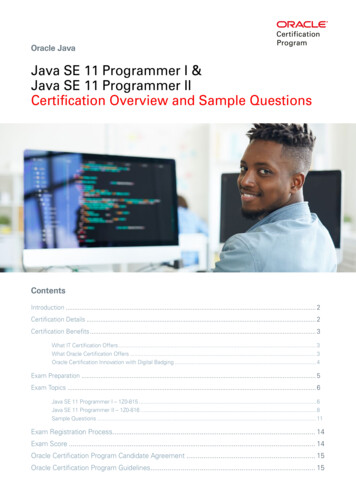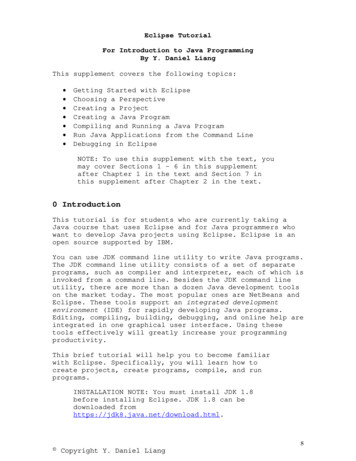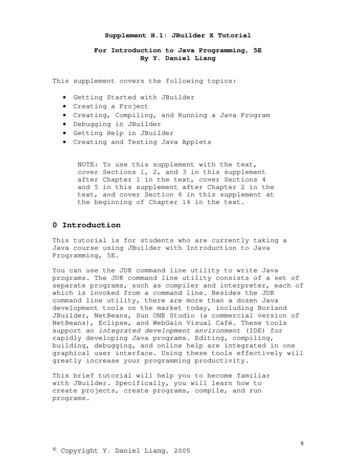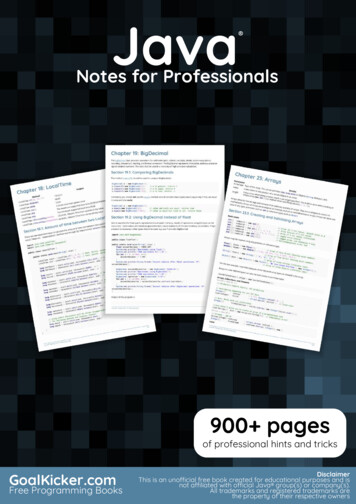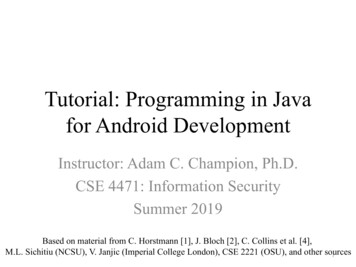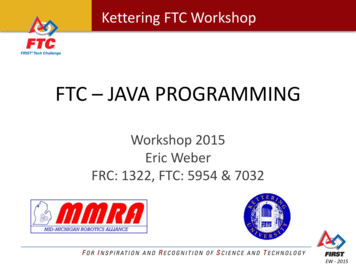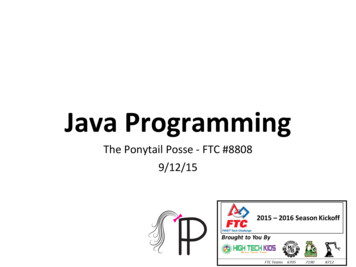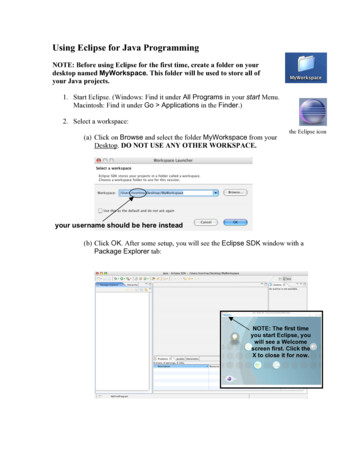
Transcription
Programming in JavaA C Norman, Lent Term 2008Part IA
2
Contents1 Preface1.1 What is programming about? . . . . . . . . .1.2 What about good programming? . . . . . . .1.3 Ways to save time and effort . . . . . . . . .1.3.1 Use existing resources . . . . . . . .1.3.2 Avoid dead-ends . . . . . . . . . . .1.3.3 Create new re-usable resources . . . .1.3.4 Documentation and Test trails . . . .1.3.5 Do not make the same mistake twice .1.4 Where does Java fit in? . . . . . . . . . . . .2 General advice for novices778991010101012133 Introduction3.1 Introduction . . . . . . . . . . . . . . .3.1.1 Books . . . . . . . . . . . . . .3.2 Practical work . . . . . . . . . . . . . .3.2.1 Exercises . . . . . . . . . . . .3.3 A Cook-book Kick-start . . . . . . . .3.3.1 Code Layout . . . . . . . . . .3.3.2 Emacs . . . . . . . . . . . . . .3.3.3 Drawing to a window: JApplets3.3.4 HTML and appletviewer . . . .3.3.5 Exercises . . . . . . . . . . . .15151821242833343742434 Basic use of Java4.1 Data types, constants and operations4.1.1 Reserved Words . . . . . .4.1.2 Basic Types . . . . . . . . .4.1.3 Exercises . . . . . . . . . .4.2 Operators and expressions . . . . .4949495165713.
CONTENTS44.34.44.54.64.74.854.2.1 Exercises . . . . . . . . . . . . . . .Control structures . . . . . . . . . . . . . . .4.3.1 Exercises . . . . . . . . . . . . . . .Control structures Part 2 . . . . . . . . . . .4.4.1 Expression Statements . . . . . . . .4.4.2 Blocks . . . . . . . . . . . . . . . .4.4.3 Null statements . . . . . . . . . . . .4.4.4 if . . . . . . . . . . . . . . . . . . .4.4.5 while, continue and break . . .4.4.6 do . . . . . . . . . . . . . . . . . . .4.4.7 for . . . . . . . . . . . . . . . . . .4.4.8 switch, case and default . . .4.4.9 return . . . . . . . . . . . . . . .4.4.10 try, catch and throw, finally4.4.11 assert . . . . . . . . . . . . . . .4.4.12 Variable declarations . . . . . . . . .4.4.13 Method definitions . . . . . . . . . .4.4.14 Exercises . . . . . . . . . . . . . . .Java classes and packages . . . . . . . . . . .4.5.1 Exercises . . . . . . . . . . . . . . .Inheritance . . . . . . . . . . . . . . . . . .4.6.1 Inheritance and the standard libraries4.6.2 Name-spaces and classes . . . . . . .4.6.3 Program development with classes . .Generics . . . . . . . . . . . . . . . . . . . .4.7.1 Exercises . . . . . . . . . . . . . . .Important features of the class libraries . . . .4.8.1 File input and output . . . . . . . . .4.8.2 Big integers . . . . . . . . . . . . . .4.8.3 Collections . . . . . . . . . . . . . .4.8.4 Simple use of Threads . . . . . . . .4.8.5 Network access . . . . . . . . . . . .4.8.6 Menus, scroll bars and dialog boxes .4.8.7 Exercises . . . . . . . . . . . . . . .Designing and testing programs in Java5.1 Different sorts of programming tasks . .5.2 Analysis and description of the objective5.2.1 Important Questions . . . . . .5.2.2 Informal specifications . . . . .5.2.3 Formal descriptions . . . . . . 181
.155.165.175.1855.2.4 Executable specifications . . . . . . . .Ethical Considerations . . . . . . . . . . . . .How much of the work has been done already?What skills and knowledge are available? . . .Design of methods to achieve a goal . . . . . .5.6.1 Top-Down Design . . . . . . . . . . .5.6.2 Bottom-Up Implementation . . . . . .5.6.3 Data Centred Programming . . . . . .5.6.4 Iterative Refinement . . . . . . . . . .5.6.5 Which of the above is best? . . . . . .How do we know it will work? . . . . . . . . .While you are writing the program . . . . . . .Documenting a program or project . . . . . . .How do we know it does work? . . . . . . . . .Is it efficient? . . . . . . . . . . . . . . . . . .Identifying errors . . . . . . . . . . . . . . . .Corrections and other changes . . . . . . . . .Portability of software . . . . . . . . . . . . .Team-work . . . . . . . . . . . . . . . . . . .Lessons learned . . . . . . . . . . . . . . . . .Final Words . . . . . . . . . . . . . . . . . . .Challenging exercises . . . . . . . . . . . . . 042052062072082086 A representative application2196.1 A Lisp interpreter . . . . . . . . . . . . . . . . . . . . . . . . . . 2196.1.1 Exercises . . . . . . . . . . . . . . . . . . . . . . . . . . 2337 What you do NOT know yet2358 Model Examination Questions8.1 Java vs ML . . . . . . . .8.2 Matrix Class . . . . . . . .8.3 Hash Tables . . . . . . . .8.4 Compass Rose . . . . . . .8.5 Language Words . . . . .8.6 Exception abuse . . . . . .8.7 Queues . . . . . . . . . .8.8 Loops . . . . . . . . . . .8.9 Snap . . . . . . . . . . . .8.10 Partitions . . . . . . . . .8.11 Laziness . . . . . . . . . .237237238238239239240240240240241241.
.228.238.248.258.268.279Cryptarithmetic . . . . . . .Bandits . . . . . . . . . . .Exception . . . . . . . . . .Features . . . . . . . . . . .More features . . . . . . . .Debate . . . . . . . . . . . .Design . . . . . . . . . . . .Filter (Coffee?) . . . . . . .Parse trees . . . . . . . . . .Big Addition . . . . . . . .Lists in Java . . . . . . . . .Pound, Shillings and OuncesDetails . . . . . . . . . . . .Name visibility . . . . . . .Several Small Tasks . . . . .Some Tiny Questions . . . .Java 1.5 or 5.0 versus previous versions9.1 An enhanced for loop . . . . . . . . . . .9.2 Generics . . . . . . . . . . . . . . . . . . .9.3 assert . . . . . . . . . . . . . . . . . . .9.4 Static imports . . . . . . . . . . . . . . . .9.5 Auto-boxing . . . . . . . . . . . . . . . . .9.6 Enumerations . . . . . . . . . . . . . . . .9.7 printf . . . . . . . . . . . . . . . . . . .9.8 Scanner . . . . . . . . . . . . . . . . . . .9.9 Variable numbers of arguments for methods9.10 Annotations . . . . . . . . . . . . . . . . .9.11 Enhanced concurrency control . . . . . . 253253254254254254254255255255256256
Chapter 1Preface1.1 What is programming about?There are two stories you can tell yourself about what this course is going to do foryou. The first is the traditional one that it is so you can learn some Java. Acquireknowledge and skills. The second, which may be more interesting, is to see thiscourse as part of your journey as you start to become (or at least appreciate whatit is to be) a Computer Scientist. This second perspective suggests that there maybe something for you here whether or not you believe you are already skilled inJava, and it challenges you to look beyond the mere details to the tought patternsthat link them together.In the early days of computers programming involved a full understanding ofthe way that the hardware of your computer worked, your program, when run,took over essentially the whole machine and it had to include everything neededto manage input and output. In extreme cases one started the process of loading code into a computer by using hand-switches to place bit-patterns directlyinto the machine’s memory. After a while operating systems came along andprovided serious insulation from that level of extreme awareness of hardware, andhigh-level languages make it possible to express programs in at least semi-humanunderstandable form. But still the emphasis was on “writing a program”, whichtended to be a stand-alone application that solved some problem.Libraries of pre-written sub-programs grew up, but for a very long time theones that anybody could rely on having access to were either rather specialist orthe functionality that they provided was at a rather low and boring level. Therewere libraries that could really help you with serious tasks (such as building awindowed user-interface) but none of them gained really global acceptance, andonly a few were of any use on more than one brand of computer. The libraries thatwere standard with typical programming languages provided for fairly limited file7
8CHAPTER 1. PREFACEand terminal access input and output, modest string handling and really not a lotelse. Operating systems made their capabilities available in the form of librariesthat programs could call on, but overall coherent design was rare and use of these“libraries” led to inherently non-portable code.Building a new library was not part of the common experience of programmers, and indeed large-scale re-use of code was the exception rather than the rule.There has been an ideal or a dream of re-usable software components for ages,but it is only recently that it has started to become something that can be notjust feasible but reasonably convenient. Java is one of the languages that encourages this move, and the whole Object Oriented Programming movement that Javaforms part of provides a context.So in the old world one thought of a program as a large complicated thingthat called upon facilities from a few fixed libraries that you happened to haveavailable. Today instead of that you should often start a project with the intentionof developing a set of new re-usable and general libraries that themselves build onand extend existing software components. You will design these libraries so thatonce they exist the program you had to write becomes a fairly simple applicationof them: it will do some minor customisation and link together different unitswithin the overall structure of your libraries, but with luck it will of itself befairly small and straightforward. If you do this well you will find that the libraryyou have created will serve you well in future projects, or it may even becomesomething worth circulating (or selling) of itself. With these ideas in mind youwill want to make it well-structured, robust and you may even feel motivated toaccompany it with some coherent documentation!So overall the mind-set for the 21st Century is that you design and write reusable components and libraries, and that writing mere stand-alone programs is aterribly old-fashioned and dull thing to do!1.2 What about good programming?The first and utterly overriding character of a good program is that it must be fitfor its purpose. Good programming must not only lead to a good program, butshould do so in a way that reaches a successful conclusion reliably and withouttaking more time and effort than is really required.These comments may seem bland and self-evident, but they have real consequences! The first is that you can not judge a program until you know what itspurpose is. Even though almost all the exercises you will do this year will beboth small and will never have any part of their code re-used it will be proper foryou to practise writing them as if they are much larger and more important. Thatwill mean that you are expected to accompany the code you write with both notes
1.3. WAYS TO SAVE TIME AND EFFORT9about its external behaviour and how to use it and with comments that describe itsinternal structure and organisation. For certain sorts of library code it will makesense to use the documentation arrangements that the main Java libraries use. Thisinvolves things called “documentation comments” and a utility called javadocthat will be described later.Without this documentation you may believe that your programs meet theirpurpose but you do not have any basis for expecting others the agree.1.3 Ways to save time and effortWorking with computers can swallow up an astonishing amount of time. To beable to get everything you need done you will want to find ways of economising.The key to doing this effectively is to concentrate on techniques that save time inthe long run. Some ideas that appear to speed things up in the short run can endup costing more later on!1.3.1 Use existing resourcesYou are encouraged to use code-fragments from these notes in any way you want.You can sometimes get a fresh project off the ground by extracting at least fragments from a previous piece of work you have done. The Java libraries are yourfriend: they contain facilities to do many of the things you will find yourself needing. In general before you ever write anything from scratch for yourself considerwhether there is something that can give you a head-start.Everybody might reasonably worry that the above paragraph could be seen asan invitation to plagiarise! Do not take it that way: couple it with a very firm remark that when you use other material you should acknowledge your sources, andyou should not pillage the material of those who are unwilling to make their workavailable to you. As far as tickable exercises for this course are concerned you areencouraged to discuss what you are doing with friends and supervisors, and collect code-sketches and fragments from them, provided that when you submit yourwork to the department you really understand everything in your submission andyou have learned enough that (if necessary) you could then instantly and comfortable re-create your submission in a sound-proof booth visibly cut-off from furtherhelp. So rather than sit and suffer in isolation, seek web-sites, friends, demonstrators, books and code libraries to give you guidance so long as you learn from thenand do not just blindly copy!
10CHAPTER 1. PREFACE1.3.2 Avoid dead-endsSometimes you can start designing or writing some code and as you go thingsseem to get harder and harder. Something is not working and you have no ideawhy. You do not want to get in such a state! Clear advance planning and a wellorganised set of working habits are the best way to avoid the mess. If you findyourself in what feels like a dead-end then avoid (a) panic (b) a tendency to tryalmost random changes in the hope that things will improve and (c) temptationto work all afternoon, evening and night until you solve things. Go back andlook at your plan. If necessary refine it so you can make progress in tiny steps.Explain your plan and your code to somebody else (either in person or in the formof written documentation). But do not just get bogged down: taking a break andcoming back fresh can often save overall time.1.3.3 Create new re-usable resourcesAn ideal that this course would like to instil in you is one of creating re-usablebodies of code. This will take more care and time when you first implement them(and of course anything re-usable deserves proper documentation and testing) butthat can be well paid back when you get a chance to call on it again. At a minimum this can include keeping all your working code from both the tickable andother exercises in these notes so you can use parts of them as templates in futureprojects.1.3.4 Documentation and Test trailsNeatly formatted code with clear comments and a well set out collection of testcases can seem slower to write then a jumble of code that is just thrown together.However long experience suggests that the jumble of code is much less likely towork first time, and that especially as your projects get bigger that early investmentin good habits pay dividends.1.3.5 Do not make the same mistake twiceEspecially while learning a new language, such as Java, you will make mistakes.As you design and write gradually larger and larger bodies of code you will makemistakes. Observe and appreciate these, and try to observe yourself as you uncover and correct them. Possibly even keep a small notebook of “bugs I have hadin my code”. Then each time you make a mistake seek some scheme that can prevent the same one from causing significant trouble in the future. Your fingers willalways leave typos in everything you write and your mind can always wander: the
1.3. WAYS TO SAVE TIME AND EFFORT11idea is not to avoid glitches totally, it is to build up a personal toolkit of ways toovercome them without pain or waste.
CHAPTER 1. PREFACE121.4 Where does Java fit in?There are those who believe that Object Oriented Design and Programming is The Answer to reliablelarge-scale system building, a silver bullet1 that curesthe major woes of the last fifty years of over-costly andhaphazard use of computers. Java is one of the majorpractical and widely-used languages that fall withinthe Object Oriented family. Key attitudes that comewith this are that projects should be structured into potentially re-usable blocks (the Java class constructthat you will learn about later being a major way ofachieving this). These blocks should each take responsibility for just one aspect of the overall behaviour youare trying to code up. The decomposition should bearranged so that interaction between blocks is as tidyand disciplined as possible.Overall at least a rough caricature is that ML Figure 1.1: Silver Bulletstresses absolute correctness via mathematically styled Needed.structure, and encourages very concise programmingstyles. Java on the other hand follows a view that language constructs that supportlarge-scale structuring of projects are the key. It also expects that having the userwrite out types and qualifiers explicitly will help others to read your program.ML as taught last term provides a fairly basic library, but mostly you spend theMichaelmas Term writing stand-alone programs and fragments. With Java thereis heavy emphasis on a rich (and perhaps hence complicated) library that supportsa very full range of computing needs.1 Bradwords.Cox in Byte magazine October 1990, pp 209–218 puts things in much these extreme
Chapter 2General advice for novicesFollowing tradition, I provide ten items of guidance for the benefit of those whoare relatively new to programming. I hope that each of these will be re-inforcedduring the course as a whole, but here they are collected together at the beginning:1 Understand the task you are about to solve before starting to write a program about it. Work through methods and procedures by hand on paperetc. Plan some test cases. Identify cases that will represent boundariesor oddities. In general prepare a plan before you start going anywherenear a computer;2 Sketch the structure of the whole of your code out informally so you havefull overview before fussing about exact syntax etc. Ensure you knowwhat you expect that the computer will do. This initial sketch can bevery informal, and may be in terms of diagrams rather than anything thatlooks much like real programming. The key word here is “structure”.This applies with way greater force when your code starts to grow: youshould always design a good way to factor your code into reasonablyself-contained and independent components (each will be one “class” inyour code) right from the start;13
14CHAPTER 2. GENERAL ADVICE FOR NOVICES3 Write out key parts of above in the form of comments before you startthe real code. Concentrate in these comments on the “what” and “why”of your code rather the details of “how”. This will really help when youshow your work to somebody else because you need help! I will explainthis one again: The first thing you will type into a computer when youstart writing any program will be a set of overview comments that explainits strategy and structure;4 At least for a first version of anything, favour clarity and obvious correctness over pretty well everything else. Clever tricks, worries aboutefficiency, generalisations etc can come later;5 Neat consistent layout and thoughtfully named fields, methods, variablesetc. are a good investment of your time. Cryptic is bad even if it saveskeystrokes in the short term;6 If a task is too big to solve in just one gulp look for ways of breaking itdown into sub-tasks. As you do this think about ways you will be able totest code you write for each sub-task and work on the whole thing stepby step;7 When you try to compile your code and see a syntax error do not panic.Learn to interpret the compiler’s diagnostics. And only try to removeone error at a time: count it as a success if next time you try to compilethe first error has give so you can then concentrate on the second;8 When you have compiled your program and run it and it gives wronganswers or behaves badly do not panic. First work to understand what iswrong and only after you have found where the problem is think aboutways to fit it. Do not just try random changes! Eg. confirm what yourprogram actually does by adding assert and extra print statements;9 Whenever you find you have to change your program review comments,consider if it will now do exactly what you want, and re-run all your testcases. Experience shows that changes (for whatever cause) can introducenew problems while you are in the process of fixing old ones;10 If you find you are spending a seriously long time trying to make senseof anything then find help from friends or a supervisor or a book. Do notjust keep building up your frustration not getting anywhere!
Chapter 3Introduction3.1 IntroductionWe have been using Java as a first-year teaching language here in Cambridgesince 1997-8. We teach this course following on from “Foundations of ComputerScience” which used ML, and there are a number of things it is intended to do:1. Provide all of our students with exposure to a common programming language that can be used by later courses and practical work in the CST;2. Introduce the syntax that is (almost) common to several of the most widelyused practical programming languages today (the syntax of Java has a greatdeal in common with that of C and C , so having learned Java you arequite a long way to understanding those languages too);3. Discuss the process of designing, writing and debugging programs and raisesome awareness of issues of style;4. Present the Object Oriented aspects of a programming language as meansto enforce modularity in large programs;5. Teach basic use of Java, a language that has significant relevance in theoutside world today.Note that in our Part IA course “Software Engineering II” provides significant extra coverage on issues of structuring programs (especially ones that are large ordeveloped by collaborative work in a group), and in Part IB course there is a lecture course once entitled “Further Java” and now renamed ”Concurrent Systemsand Applications”: it should not be imagined that I will cover all aspects of thelanguage or its use here!15
16CHAPTER 3. INTRODUCTIONThe nature of teaching a course involving programming in some particular language means that some features need to be mentioned well before the place wherethey can be fully explained, and so it will not make sense to keep the presentationin lectures totally linear and tied to these notes, but for supervision purposes thestructure shown here should suffice. With each section I will have a few examplesor exercises. Especially at the start of the course these will often be pretty silly,but the ones right at the end can be viewed as samples of the sort of question thatmight arise in the examination. Although I want some of my examples to be niceand easy I would like to have others that are interesting challenges for those whoalready think they know it all (ha ha). It is always very hard to judge the amountof trouble these will give you all, so if they are either too easy or too difficultI apologise. Examination questions will be set on the supposition that you haveattempted a reasonable sampling of the exercises.The aim of these notes is that they should serve both as guidance to studentsand to supervisors, and so there is no separate supervisor’s guide. Originally I hadintended that they would be structured into sixteen sections corresponding to thesixteen lectures available. As I prepared the notes I concluded that such a rigidarrangement was not tenable. Thus the lectures can be expected to cover roughlythe material in these notes in roughly the same order, with an approximation toone-sixteenth of the entire notes corresponding to each lecture!It might be noted that a Java course for the Diploma students runs during theMichaelmas term. The lecture notes associated with that course may provide apresentation of Java which is different from mine and thus may complement mylectures or shed light on issues that I fail to.The course is be based on use of the version of Java sometimes known as“Java 5.0” and sometimes as “Java 1.5” or 1.6. This should now be counted asthe current and widely-used version, but if you use computers other than the mainuniversity ones here you may come across earlier releases. Please avoid them forcourse-related work to avoid confusion.Some members of the audience for this course will already have significantpractical experience with Java. Others will have written lots of programs beforebut in C, C or Pascal, but the only thing I can properly assume here is thateverybody has attended the Foundations of Computer Science course given in theMichaelmas term and hence that everybody is used to writing code in the languageML. While those who have seen Java before will undoubtedly find the first fewlectures and exercises here very easy, I hope that they will find material that is newand worth-while being introduced in due course. In the first year that this coursewas given it was observed by one Director of Studies at a large College that someof his students who did already know Java concluded on that basis that they neednot attend the lectures, but that their examination results indicated that this hadnot been a perfect judgement call.
3.1. INTRODUCTIONFigure 3.1: Reproduced courtesy Kevin McCurley.17
18CHAPTER 3. INTRODUCTION3.1.1 BooksAll bookshops these days seem to devote many metres of shelf-space to books thatpurport to teach you Java in a given small number of days, to help you even if youare an “idiot”, or to provide “comprehensive and detailed” coverage of even thoseparts of Java that the language definers have left deliberately vague. I believe thatthis is a course where it is important for every student to have their own copyof a supporting textbook/manual. But the issue of which book to buy will endup a somewhat personal choice since differing levels of detail will suit differentstudents! Browse the following in libraries and bookshops, talk to students inhigher years and seek advice from your Directors of Studies and Supervisors aboutwhat is liable to suit you.My first recommendation has as most of its pages what is in effect hard copyof the on-line detailed documentation of the Java library. As a result it is not asmooth consistent read, but I find that very many people need that information inprinted form while they are getting used to navigating the library and understanding what it can do for them.Java in a Nutshell fifth edition (Feb 2005)Java Foundation Classes in a Nutshell (1999)David FlanaganO’ReillyThere are two books[11, 6] that I think you might reasonably consider and thatare probably easier for self study in that they do not get so rapidly enmeshed infull detail.Thinking in JavaBruce EckelPrentice-Hall, 2002 third editionandJava GentlyJudy BishopAddison Wesley, 2003, third editionEckel’s book is distributed (at no cost) via www.eckelobjects.com so ifyou are actually prefer reading computer screens to real books it counts as a greatbargain!Some Directors of Studies will strongly point you towards the book[2] thatwas that main text for this course a couple of years ago:Objects First with Java: a Practical Introduction using BLUEJDavid Barnes and Michael KöllingPrentice Hall/Pearson, 2005, second edition
3.1. INTRODUCTIONFigure 3.2: Not (quite) the main course book.19
20CHAPTER 3. INTRODUCTIONThis book emphasises issues of overall program structure and design aboveconcern for the exact details of the Java language or its libraries and so is almostexactly the antithesis of the Nutshell books! It was used as the main teaching texthere in 2003-4, and you may find the BlueJ software (http://www.bluej.org)provides a useful environment within which to develop and test your code. Notethat this year’s edition of both the book and the software has developed from theversions available last year.There will be plenty of other useful books, and any individual student mayfind a different one especially to their own taste. If selecting a book other thanthe one I suggest that you make sure that what you learn from it can be related tothe lectures that I give. Since this year we are using a rather new version of Javabeware that old editions of books may not be s
Chapter 1 Preface 1.1 What is programming about? There are two stories you can tell yourself about what this course is going to do for you. The first is the traditional on
